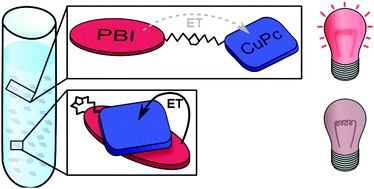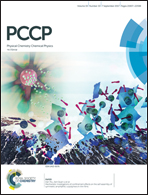Excited state dynamics and conformations of a Cu(ii)-phthalocyanine-perylenebisimide dyad†
Abstract
We investigate the excited state dynamics and the conformations of a new molecular donor-bridge-acceptor system, a Cu(II)-phthalocyanine (CuPc) covalently linked via a flexible aliphatic spacer to a perylenebisimide (PBI). We performed time-resolved polarization anisotropy and pump–probe measurements in combination with molecular dynamics simulations. Our data suggest the existence of three conformations of the dyad: two more extended, metastable conformations with centre-of-mass distances >1 nm between the PBI and CuPc units of the dyad, and a highly stable folded structure, in which the PBI and CuPc units are stacked on top of each other with a centre-of-mass distance of 0.4 nm. In the extended conformations the dyad shows emission predominantly from the PBI unit with a very weak contribution from the CuPc unit. In contrast, for the folded conformation the PBI emission of the dyad is strongly quenched due to fast energy transfer from the PBI to the CuPc unit (3 ps) and subsequent intersystem-crossing (300 fs) from the first excited singlet state of CuPc unit into its triplet state. Finally, the CuPc triplet state is deactivated non-radiatively with a time constant of 25 ns.



 Please wait while we load your content...
Please wait while we load your content...